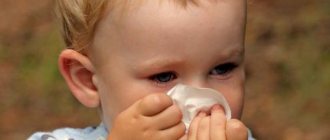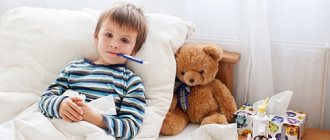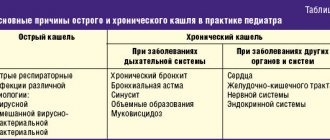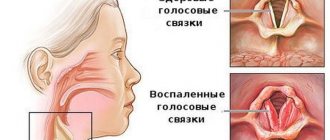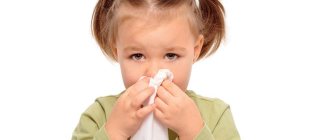An infant has an incompletely formed body. It has weak protective functions. That is why his body cannot cope with some infections and diseases. At 6 months, many even low-toxic medications are contraindicated for a baby. It is quite difficult to cope with the disease that has arisen. It is also worth noting that some symptoms, which at first glance may indicate some kind of disorder, may be the norm. In an incompletely formed organism, certain symptoms arise reflexively and do not require treatment. Many parents do not know how to treat a cough in a 6-month-old child. They are sure that these symptoms are caused by a cold. However, this is not always the case.
The appearance of a cough with a runny nose is typical not only for older children, but also for infants
Cause of the disease
It is impossible to independently find out why a six-month-old baby has a dry cough and runny nose. This is due to the fact that the same symptoms can indicate a wide variety of diseases. Dry and wet cough is often present in infants.
A runny nose in nature can be:
- infectious;
- non-infectious.
Most often, infants experience a non-infectious type of runny nose. This phenomenon occurs due to the fact that the mucous membrane of the nasal passages adapts to the environment. This type of runny nose is physiological and is not a symptom of any disease.
A runny nose may be a consequence of teething in a child.
A non-infectious type of nasal discharge may also indicate:
- about the presence of an allergic reaction to anything;
- that the baby is teething;
- that there is a foreign body in the nasal cavity;
- about the presence of injuries of various types.
The non-infectious type of the disease is diagnosed when the child has absolutely clean lungs and no elevated body temperature.
With an infectious type of runny nose, the baby’s temperature rises
Otherwise, the presence of an infection may be suspected. It will be more difficult to cure such a disease. If it is present, the following symptoms occur:
- increased body temperature;
- swelling of the nasal mucosa;
- refusal to eat;
- anxiety;
- the child breathes through his mouth.
Cough can also be of different types. There are two types of this symptom:
- physiological;
- pathological.
Inflammation of the nasal mucosa in a baby causes coughing attacks with a runny nose
Physiological coughing does not indicate the presence of a disease. It is considered the norm. This cough does not require special treatment.
A pathological cough is a sign of illness. It signals that there are any disturbances in the upper or lower respiratory tract. A severe cough and runny nose can occur when the following diseases develop in the body:
- rhinitis;
- inflammatory process in the trachea, nasal cavity, lungs or larynx;
- bronchial type asthma;
- individual intolerance to something;
- improper functioning of the gastrointestinal tract;
- inflammatory process in the gums.
Problems with the gastrointestinal tract can cause a cough with a runny nose in a child
It is not uncommon for a 6-month-old child to have a cough and runny nose due to a cold. Often in this case there is an increased body temperature. In this case, the baby may constantly sneeze.
Colds
A cold is often accompanied by a cough and runny nose in a 6-month-old baby. For children, such a violation can cause a lot of discomfort. The child may have both a wet and dry cough. It can also be paroxysmal. Before you start figuring out what to give your child for a cough, you need to make sure that the symptoms are pathological. The baby will need to be examined by a doctor.
A cold may initially occur without fever. If left untreated, its indicators may increase insignificantly. ARVI is accompanied by the following symptoms:
- increase in body temperature;
- anxiety;
- lack of appetite;
Runny nose, cough, fever and tearfulness - all this manifests itself when a child has a cold
- change in the characteristic features of bowel movements, namely diarrhea.
ARVI is also characterized by dry coughing. Over time, mucus begins to form and come out.
In a 6-month-old child, cough is perceived as a disorder when it is accompanied by undesirable symptoms or occurs in attacks.
The following symptoms may also occur with ARVI:
- enlarged lymph nodes in different parts of the body;
- enlargement of some internal organs;
Among other symptoms, a child’s lymph nodes may become inflamed due to a cold.
- inflammation of the mucous membrane of the eyes;
- profuse lacrimation;
- rashes in different parts of the body.
In the first year of life, a cold may be complicated by croup. In this case, significant swelling of the larynx occurs. The color of the baby's skin and lips may change. With this pathology, a small child cannot breathe fully. Attacks of suffocation may occur periodically. This complication requires immediate medical attention.
For croup, first aid may be required. That is why parents should find out in advance how they can alleviate the baby’s condition. If a complication occurs, you need to:
- immediately call an ambulance;
- calm the child;
If you have croup, you need to call an ambulance as soon as possible and give your child non-carbonated mineral water before it arrives.
- take the baby to the bathroom and turn on the hot water, you need to resort to steam inhalation (it is advisable to add a small amount of soda to the water);
- The child should be given mineral water to drink without gas; it should be at room temperature.
You need to act immediately. Otherwise, the child’s condition will deteriorate significantly.
How to cure a cough and runny nose in a 5-month-old child without antibiotics - Useful tips
Let's agree right away: no article, including this one, and no useful advice can ever replace a doctor's consultation!
Be sure to contact a good specialist at the first opportunity!
And only if there are absolutely no other options, do something on your own.
What exactly? But let’s talk about this today. And we’ll find out how to cure a runny nose and cough in a 5-month-old child without the use of antibiotics. About conditions conducive to recovery that we can create ourselves. And about actions that will help the child move towards recovery.
So, let's take it in order.
If your child's temperature rises, snot and cough appear. What should and can you do for your baby?
First of all, create an environment for your child that is conducive to recovery - air humidity - 70%, ventilation every 40 minutes. — it is after this time that microbes and viruses begin to accumulate and become active in the air.
When dad returns from work, the first thing you do is send him to wash his hands . Right from the door. It is advisable to apply Oxolinic ointment in the nose of both yourself and your dad. Your viruses and germs that dad brings from work should not get on your baby.
Be sure to walk for 5 minutes if the child’s temperature is slightly elevated, and for 10-15 minutes. if there is no temperature. At least 3 times a day - fresh air is the best way to promote the baby’s recovery. If the weather is windy, at least go out onto the open balcony.
If your baby's nose is stuffy, rinse it every 30 minutes with saline solution, or make a saline solution with edible sea salt - 1/3 tsp. salt to 1/2 cup water. The solution temperature should be 37 degrees. Wait a couple of minutes and suck out the nozzles with a special suction device or a bulb. The pharmacy will tell you what it looks like.
Drinking plenty of fluids goes without saying! Brew chamomile and give it to your baby, also warm, and if you are breastfeeding, then use it more often! If the baby refuses to drink, do not give up, take and pour a couple of teaspoons every 10-15 minutes.
If the baby has a temperature of 38.5, give an antipyretic.
Before this, it is better not to lower the temperature, but you can alleviate the baby’s condition by wiping him with a diaper soaked in cool water or a weak solution of vinegar. Do not wipe with vodka under any circumstances - it is poison! Even if your doctor advised you to do this, believe me, there are such super pediatricians too!
And in general, you shouldn’t get carried away with pills. Most of them are not intended for small children at all. For example, in the drug Koldakt, the instructions for use directly state that it is intended only for children over 12 years of age. So read carefully what exactly you are going to give to your 5 month old baby.
If there is no temperature, then you can gently rub your chest (except for the heart area), back and feet with star balm 2-3 times a day.
You can also buy complex of essential oils . Just drop a couple of drops on the bedding so that the baby breathes in vapor. But also, be careful so that the baby does not have allergies. Some parents give 2-3 drops of “Breathe” to older children with food, and their children get sick much less often.
As for the cough, if it is dry, then the first thing you need to do is make sure that the sputum begins to leave . Inhalations with mineral water or the same saline solution are very effective, but! - be careful.
Depending on the dispersion of the inhaler, the effect on different parts of the respiratory tract occurs.
The nebulizer converts water into steam; it reaches only the upper respiratory tract . Inhalations can be carried out 2-3 times a day, but it is best to consult a specialist about inhalations.
A red throat also requires treatment - “sprinkle” myrrh . If the baby does not allow such a procedure, then - on the pacifier and in the mouth.
Source: https://detochki-doma.ru/kak-vyilechit-kashel-i-nasmork-u-5-ti-mesyachnogo-rebenka-bez-antibiotikov-poleznyie-sovetyi/
ethnoscience
For mild forms of the disease, treatment can be carried out using traditional medicine. Natural ingredients are safer, unlike medications. When used correctly, they cannot cause side effects. However, they can only be used after consulting a doctor. He will explain why the child has a cough and runny nose, how to treat such an illness and will select the safest remedy.
You can get rid of coughing and runny nose attacks with the help of Kalanchoe
For a 6-month-old child, severe cough and nasal discharge cause great discomfort. He cannot breathe fully. Kalanchoe can be used to treat a runny nose. To do this you will need to take:
- 5 drops of the plant;
- 5 drops of warm water.
The components are mixed and instilled into each nasal passage. After this, the baby may begin to sneeze heavily. No worries. This indicates that the drug has begun to have a positive effect on the respiratory system.
Sea salt has healing properties. It is often used to treat diseases of the respiratory system. The solution is dripped into each nostril. This remedy allows you to get rid of swelling of the nasal mucosa. The medicine also disinfects it.
Sea salt solution will help with a runny nose
Beetroot is highly effective. To prepare the medicine you will need to take:
- 5 drops of beet juice;
- 5 drops of warm water.
If there is severe inflammation in the nasal cavity, take a little less beet juice. Use this medicine three times a day.
Cough can be treated with mustard. To carry out therapy you will need to take:
- honey;
- flour;
- mustard;
- vegetable oil.
To relieve symptoms, you can prepare a compress for your child yourself.
All ingredients are mixed in equal quantities. The mixture is heated to a boil and applied to a small piece of gauze. An oilcloth is placed on the child’s back, and then the fabric with the product is placed. The baby is covered with a warm blanket. It is necessary to keep the medicine until it cools down. It is worth noting that such a remedy may cause individual intolerance. Before using it, you should consult a specialist.
How to treat a cough in a 5 month old child
In infants, the respiratory muscles are weak, the immune system is underdeveloped, and the lumen of the bronchi is small. They cannot cough up mucus effectively, so they are not prescribed mucolytics to stimulate mucus production. Your pediatrician will tell you what to do if your child has a dry or wet cough.
The basis of therapy is:
- medicines;
- inhalation;
- drainage massage;
- warm drink;
- rubbing.
Irrational treatment of respiratory diseases in infants is dangerous due to complications. Therefore, medications and physical procedures should be prescribed exclusively by a pediatrician.
Medicinal drinks
Cough in a 5-month-old child should be treated with caution. To alleviate his condition, warm drinks are prescribed. Toxins released by bacteria or viruses are removed from the body with fluid. As a result, the symptoms of intoxication disappear - nausea, sweating, headaches, lack of appetite, body aches.
For nonproductive cough, children are given:
- diluted fruit juices;
- boiled water;
- children's tea;
- strained dried fruit compote;
- alkaline mineral water (still).
The drink should be warm, so it is heated to 38-39°C. Otherwise, the baby faces local hypothermia, snot and increased cough.
Drugs
Cough medicine is chosen based on its effectiveness. If sputum is not coughed up, antitussives are prescribed. In pediatrics, oral solutions and syrups based on butamirate are used, a centrally acting drug that suppresses the activity of the cough center in the brain:
- Stoptussin is an antitussive agent with antispasmodic and antitussive properties. Oral drops are prescribed if the child's weight exceeds 7 kg.
- Sinekod is an oral solution that improves respiratory function and relieves paroxysmal cough.
- Panatus forte is a syrup for unproductive coughs that has a relaxing effect on the bronchi.
For difficult to separate sputum, mucolytic and expectorant medications are used.
To prevent side effects, syrups and oral drops based on ambroxol are used:
- Ambrobene is a cough syrup that reduces the viscosity of bronchial mucus and makes it easier to cough up;
- Lazolvan is an oral solution that stimulates the cleansing of phlegm from the bronchi;
- Bronchoval is a syrup that thins mucus and makes coughing easier.
Before giving your child a mucolytic drug, consult your pediatrician.
It is difficult for babies to cough up mucus, so be sure to perform a drainage massage during treatment. Then sputum does not accumulate in the lungs, which prevents pneumonia or the transition of bronchitis to a chronic form.
Rubbing
For a cold cough, rubbing with warming ointments and balms is effective. They stimulate blood flow to the lungs, which leads to:
- increasing the tone of the respiratory muscles;
- increased nutrition of the lungs and bronchi;
- strengthening local immunity;
- reducing the viscosity of sputum.
Pharmacy rubs:
- Dr. Theiss eucalyptus - ointment with camphor, eucalyptus oil and pine needle extract. It has anti-inflammatory, warming, analgesic and mucus-thinning effects.
- Vicks Active is a warming balm with terpene and eucalyptus oils, which facilitates the passage of bronchial mucus and stimulates local immunity.
- Doctor Mom is a drug based on levomenthol, camphor, turpentine and eucalyptus oil. It has a local irritating, distracting and analgesic effect.
- Pulmex baby is an ointment with balsam tree resin, camphor, rosemary and eucalyptus essential oils. Relieves inflammation, relieves pain during bronchitis, facilitates sputum discharge.
Warming cough ointment is applied only to the chest or back. To prevent allergic reactions and bronchospasms, the wings of the nose and temples are not treated.
If pharmaceuticals are not at hand, use folk recipes. To relieve cough in an infant, the following are suitable:
- Pork fat. 100 g of fat is melted in a water bath. Add 1 tsp. dry mustard, 3-5 drops of eucalyptus essential oil. Apply only to the upper back for 30-40 minutes.
- Goat fat. Add 15 ml of propolis tincture to 100 g of melted fat. Apply to the chest, avoiding the heart area. After half an hour, the remaining product is removed with a napkin.
